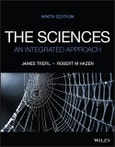The Sciences: An Integrated Approach, 9th Edition by James Trefil and Robert Hazen recognizes that science forms a seamless web of knowledge about the universe. This text fully integrates physics, chemistry, astronomy, Earth sciences, and biology and emphasizes general principles and their application to real world situations. The goal of the text is to help students achieve scientific literacy. Applauded by students and instructors for its easy-to-read style and detail appropriate for non-science majors, the ninth edition has been updated to bring the most up-to-date coverage to the students in all areas of science, with increased emphasis on climate change, sustainability, viruses and public health, and an extensively updated chapter on the importance of bioengineering.
FEATURES INCLUDE:
The Science of Life: To help show the interdisciplinary nature of the many concepts introduced in the text, sections on living things are included in most chapters. The chapters that emphasize principles specifically related to life are at the end of the book, but the biological examples appear throughout.
The Ongoing Process of Science: Science is a never-ending process of asking questions and seeking answers. In these features, some of the most exciting questions currently being addressed by scientists are examined.
Mathematical Equations and Worked Examples: Whenever an equation is introduced, it is presented in three steps: first as a sentence, second as a word equation, and finally in its traditional symbolic form. In this way, students can focus on the meaning rather than the abstraction of the mathematics. An appendix on English and SI units is also included.
Science by the Numbers: To help students understand the importance of simple mathematical calculations in areas of magnitude, several nontraditional calculations have been incorporated. For example, how much solid waste is generated in the United States, how long it would take to erode a mountain, and how many people were required to build Stonehenge.
Great Ideas and Great Ideas Concept: Each chapter begins with a statement of a great unifying idea or theme in science and a concept map so that students immediately grasp the chief concept of the chapter and how the idea relates to the different branches of science. These statements are intended to provide a framework for placing everyday experiences into a broad context.
Stop and Think! Questions challenge students to think critically about the implications of a scientific discovery or principle.
Resources for Instructors and Students including practice quizzes, flashcards, lecture slides, an instructor’s manual, images and tables from the book, a test bank, and much more!
Table of Contents
1 Science: A Way of Knowing: How do you know what you know? 1
2 The Ordered Universe: Why do planets appear to wander slowly across the sky? 30
3 Energy: Why must animals eat to stay alive? 63
4 Heat and the Second Law of Thermodynamics: Why is it easier to make an omelet from an egg than to make an egg from an omelet? 92
5 Electricity and Magnetism: What is lightning? 119
6 Waves and Electromagnetic Radiation: What is color? 151
7 Albert Einstein and the Theory of Relativity: Can a human ever travel faster than the speed of light, at "warp speed"? 185
8 The Atom: Why are there so many different materials in the world? 209
9 Quantum Mechanics: How can the electron behave like both a particle and a wave? 234
10 Atoms in Combination: The Chemical Bond: How does blood clot? 254
11 Materials and Their Properties: How have computers gotten so much faster? 289
12 The Nucleus of the Atom: How do scientists determine the age of the oldest human fossils? 316
13 The Ultimate Structure of Matter: How can antimatter be used to probe the human brain? 346
14 The Stars: How much longer can the Sun sustain life on Earth? 369
15 Cosmology: Will the universe end? 396
16 Earth and Other Planets: Is Earth the only planet with life? 422
17 Plate Tectonics: Can we predict destructive earthquakes? 458
18 Earth's Many Cycles: Will we ever run out of fresh water? 487
19 Ecology, Ecosystems, and the Environment: Are human activities affecting the global environment? 520
20 Strategies of Life: What is life? 547
21 The Living Cell: What is the smallest living thing? 576
22 Molecules of Life: What constitutes a healthy diet? 600
23 Classical and Modern Genetics: Why do offspring resemble their parents? 627
24 The New Science of Life: How did scientists develop a vaccine for COVID-19? 653
25 Evolution: How did life emerge on the ancient Earth? 685
Index I-1
Additional appendices available online only








